Traditional Viennese Apple Strudel
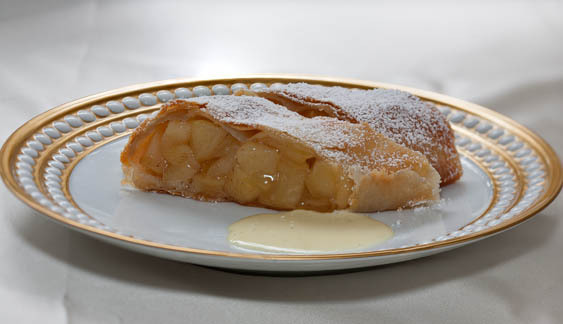
introduction
Strudel is thin, flaky pastry rolled up around a filling, usually fruit, and baked to a leafy crispness. It gained prominence in Vienna and was subsequently appropriated by the Germans but owes its European provenance to the great Austro-Hungarian Empire. Oh, and they got the whole idea from the Turks. Contrary to some Americans’ experience, strudel does not pop up out of a toaster. In terms of sheer fabrication, no pastry is easier or quicker to put together. Being essentially a noodle dough, it takes its butter post fabrication, so it can really s-t-r-e-t-c-h out first.
That stretching part occasions alarm in many who would endeavor to make strudel dough, but when the flour has the right properties and the ingredient proportions are correct, it isn’t all that difficult. We applied a number of Anson Mills flours and flour combinations to my (Kay’s) original German (subsequently multi-tweaked) recipe. Pastry flour was too soft; pasta flour was too hard. But Goldilocks found the French Mediterranean White Bread Flour just right. It had the strength to stretch without getting tough. Its flavor was delicate and clean. Superb.
This is a beautiful dessert: light on its feet after a holiday meal, while offering the satisfaction of sweet, baked apples in thin buttery, pastry, and bathed in vanilla sauce.
Baking Notes
Ingredient weights are important to this pastry dough. Even—perhaps most importantly—the egg whites. Thus, we didn’t offer approximate cup measurements. It saves us from worrying about all of you.
The apples are a matter of no small importance in this preparation, either. Of course we want them crisp, well balanced, and in the sweet-tart category. And juicy—just not too juicy. Baking a strudel is a race between getting a rather fragile dough done and sealed off before the apples begin to weep. Hence, we cannot recommend, for instance, McIntosh, or other apples known to be especially emotional. Jonagold, Pink Lady, Northern Spy—all these, yes. Mix the sugar into the apples just before you roll the strudel to minimize the opportunity for them to cry.
It is important to roll the strudel up tightly and tuck the apples in snugly!
Okay, attention, class! If ever you needed an electric knife it is for our Crêpe Cake and this strudel. The lightest pressure and vroom vroom: perfect slices!
equipment mise en place
To make this recipe, you will need a 4-foot square piece of cotton fabric (such as a queen-size flat sheet cut into 4 pieces); a digital kitchen scale; medium, small, and large mixing bowls; a whisk; a pizza stone; parchment paper; a rimmed baking sheet; a rolling pin; an apple peeler or sharp paring knife; a measuring tape; a pastry brush; a pair of kitchen scissors or a pizza wheel; a tea strainer; and an electric knife.
-
for the pastry:
-
6ounces Anson Mills French Mediterranean White Bread Flour, plus additional for stretching the dough
-
¼teaspoon fine sea salt
-
1.5ounces egg whites
-
1.2ounces almond oil (not toasted almond oil)
-
1 ½teaspoons lemon juice from ½ lemon
-
1.2ounces hot spring or filtered water
-
-
for the filling:
-
3.5 to 4.6ounces sugar
-
½teaspoon ground cinnamon
-
⅛teaspoon fine sea salt
-
3tablespoons juice from 1 or 2 large, juicy lemons
-
2pounds apples (see Baking Notes)
-
-
-
2ounces clarified butter, melted and warm
-
Confectioners’ sugar, for dusting
-
Custard Sauce (Crème Anglaise), for serving
-
-
Have ready a 4-foot square of clean cotton fabric, such as a queen-size sheet cut into quarters. Iron the fabric if it is extremely creased.
-
Make the pastry: Place the flour and salt in a medium mixing bowl and whisk to combine. Combine the egg whites, almond oil, lemon juice, and water in a small mixing bowl and beat with a fork to combine. Make a well in the flour and pour the liquid ingredients into the well. Draw the dry ingredients into the well by stirring with a fork in a clockwise direction while rotating the bowl counterclockwise with your other hand. The mixture will come together easily at first; when it becomes a shaggy dough, knead it by hand until all bits are incorporated. Turn the dough out onto a work surface and alternately knead and crash it (i.e., throw it against the work surface; fig. 2.1) for 15 to 20 minutes without adding flour. The dough should be stretchy and supple, and you should be able to coax it to windowpane translucence (fig 2.2). Return the dough to the bowl, cover tightly with plastic wrap, and let rest for at least 1 hour and up to 3 hours at room temperature.
-
Adjust an oven rack to the middle position, set a pizza stone on the rack, and heat the oven to 425 degrees. Cut a sheet of parchment paper to fit into a rimmed baking sheet.
-
Prepare the filling: While the dough rests, combine the sugar, cinnamon, and salt in a small bowl and stir to combine. Put the lemon juice into a large mixing bowl. Peel, core, and dice the apples into ½-inch cubes; as they are cut, turn the cubes into the large bowl and toss them with the lemon juice to prevent discoloration (fig. 4.1). Set aside.
-
Stretch the pastry: Spread out the fabric across a table or kitchen island. Sprinkle it with flour and rub the flour into the cloth. Turn the dough out onto the cloth, sprinkle the dough with flour (fig. 5.1), and press it into a 7-inch square. Using a rolling pin, roll out the dough to a 10 by 12-inch rectangle (fig. 5.2). Flour the tops of your hands and reach under the dough to gently stretch it from the center out using your knuckles, rotating it in a circle as you go (fig. 5.3). Feel free to lower the dough to the cloth and reflour it or your hands at any time. Continue to stretch the dough as evenly as possible. As it becomes large and unwieldy, lower it to the cloth. Pull it gently into long rectangle, with a shorter side nearest you (fig. 5.4). Stretch the thicker, opaque sections, leaving the very thin sections alone. When the dough is transparent overall and measures approximately 20 by 27 inches, you’re there. Don’t worry about small tears or the thicker edges—we’ll take care of the latter in a minute.
-
Fill the strudel: Using a pastry brush, sprinkle about one-half of the melted butter evenly over the dough, and then brush it lightly to distribute. Toss the sugar mixture into the apples, and then use your hands to distribute the apples in a long mound across the dough, about 2 inches in from the edge nearest you and leaving about 2 inches on either side. Trim away the thick lower edge with scissors (fig. 6.1) or a pizza wheel. Use the edge of the fabric to lift and roll the dough and filing tightly until the filling is completely encased in dough (fig. 6.2), then tuck the apples, compacting them into a tight mound (fig. 6.3). Continue to roll and tuck the strudel. When your strudel has arrived near the end of itself, trim away the thick edge. Roll the strudel all the way up and twist the ends of the dough like a Tootsie Roll wrapper to tighten and secure the filling. It will be a cylinder approximately 20 inches long.
-
Lay the sheet of parchment paper in front of the strudel and roll the strudel onto the paper so that it is seam side down. Curve in the long ends to create a horseshoe shape. Lift the parchment and transfer the strudel to a rimmed baking sheet and brush with about one-half of the remaining butter (fig. 7.1). Slide the baking sheet onto the pizza stone and bake the strudel until golden brown and crisp, 25 to 30 minutes, turning the baking sheet once during baking. Remove from the oven and immediately brush with the remaining butter. Let cool 10 minutes (fig. 7.2).
-
Using a tea strainer, sift confectioners’ sugar over the strudel. With an electric knife, cut it into thick slices. Serve warm with custard sauce (Schlag is appropriate as well, of course).
-
-
2.1
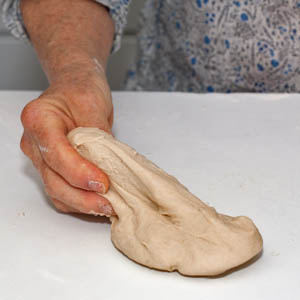
-
2.2
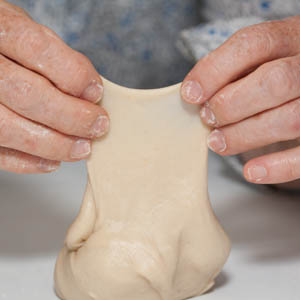
-
-
-
4.1
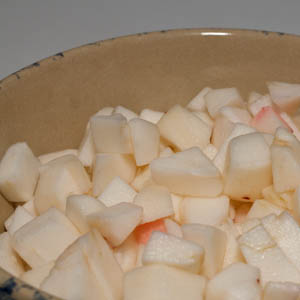
-
-
-
5.1
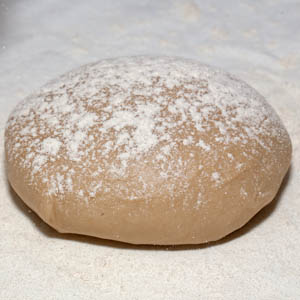
-
5.2
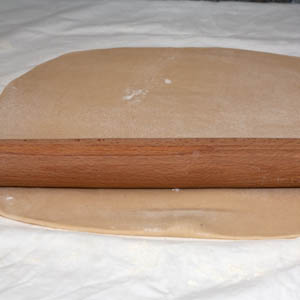
-
5.3
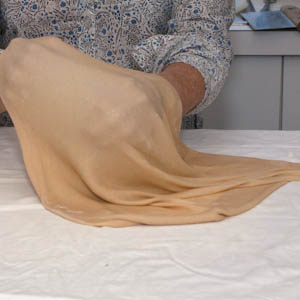
-
-
-
6.1
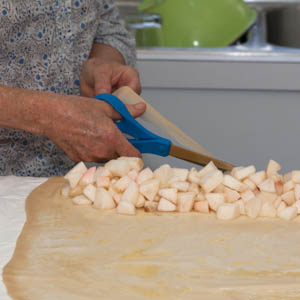
-
6.2
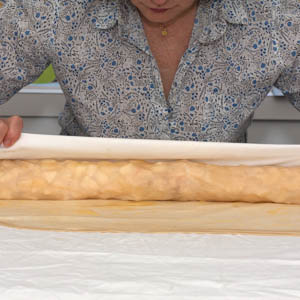
-
6.3
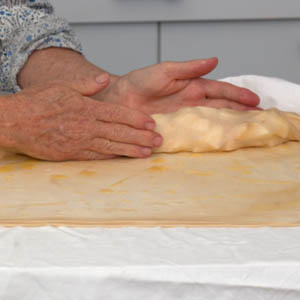
-
-
-
7.1
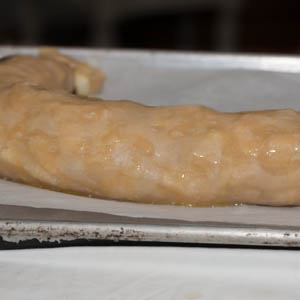
-
7.2
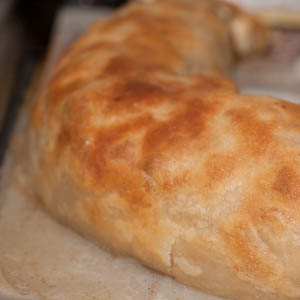
-
Step photographs by Kathy Rose